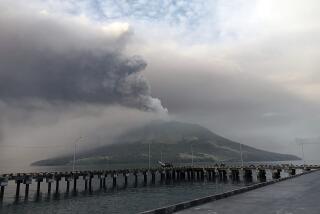Japanese Calm as Volcano Erupts Again
- Share via
DATE, Japan — A volcano in northern Japan erupted again on Saturday, a day after it roared to life and sent a spectacular plume of molten rock and ash billowing two miles above the crater and rolling down the snow-quilted slopes.
Ash dusted silent, evacuated villages near Mt. Usu after the major eruption Friday afternoon. The only other noise came from sirens screaming warnings and ambulances and police cars cruising in search of damage.
Farther away from the volcano, people streamed into the streets and climbed to rooftops to watch the towering cloud that blossomed from the eruption. Some snapped photographs of debris that rose two miles high for more than two hours.
But those in the nearby city of Date who weren’t looking out a window would barely have known that 2,416-foot Mt. Usu was erupting.
“I didn’t feel anything. I didn’t hear anything,” said Norimichi Nagao, who works for the nearby city on Japan’s northernmost main island of Hokkaido. “I didn’t even know that there was an eruption until I saw it on television.”
The mountain erupted again before dawn Saturday, brightening the sky and giving off smoke for about 10 minutes, Japan’s meteorological agency said.
Officials were still trying to determine the extent of the second eruption, as darkness at the time made it difficult to observe. However, preliminary indications were that it was less powerful than Friday’s, said agency spokesman Ippei Eiguchi.
There were no immediate reports of damage or injuries from either eruption. But more than 11,000 people evacuated from communities at Usu’s base after the earth began rumbling earlier last week spent Friday night in rescue centers.
Snow fell Friday evening, increasing concerns about mudslides in the lakeside resort area. The military was called in because of concerns over the possibility of landslides or mudslides caused by melting runoff. Two people were killed and 200 homes destroyed in mudslides after Usu’s last eruptions, which began in 1977 and continued into the next year.
Fears also remained that Usu could spew a deadly mix of gas and rocks--called a pyroclastic flow--that races down slopes and incinerates everything in its path.
Prime Minister Keizo Obuchi said that evacuees might have to stay for a while at makeshift centers set up in school gyms and community halls. The government will consider building temporary housing if that is the case, he said.
At the centers, families sat on blankets spread out to mark their private space. Some put up cardboard partitions, but there was little else to give them any sense of privacy.
About 51,000 people live in the coastal city of Date--pronounced Dah-tay--and several smaller towns near Usu, located 475 miles north of Tokyo. Experts had predicted the eruption because of increased seismic activity that began earlier in the week.
In Date, the eruption under clear blue skies became more of a public spectacle than a threat. The somewhat relaxed atmosphere was understandable: After days of small but constant earthquakes and high-level warnings, many residents were ready.
Almost immediately after the eruption, volcanic ash began to rain down on nearby towns. Residents downwind were soon enveloped by the pungent smell of sulfur.
While Date was spared ash fall by winds that blew debris from the eruption in the opposite direction, other places were not so lucky. Cars coming in from other areas around the mountain were covered in dust. Two other towns near Mt. Usu, Abuta and Sobetsu, were silent and empty, nearly all their residents evacuated.
Some area residents expressed a mixture of relief and anxiety after the long-awaited eruption.
“I’m happy I’m safe, but I’m afraid this will do huge damage to my business,” said 53-year-old scallop cultivator Yomiko Yasuko, who was out at sea when the volcano erupted.
Japan is one of the world’s most eruption-prone countries, with 86 active volcanoes.
*
On the Net:
Smithsonian Institution’s Global Volcanism Program: https://www.nmnh.si.edu/gvp/
Volcanoes Online (geared toward children): https://library.thinkquest.org/17457/english.html
The Volcano Information Center: https://www.geol.ucsb.edu/~fisher/
The Electronic Volcano: https://www.dartmouth.edu/~volcano/
More to Read
Sign up for Essential California
The most important California stories and recommendations in your inbox every morning.
You may occasionally receive promotional content from the Los Angeles Times.












